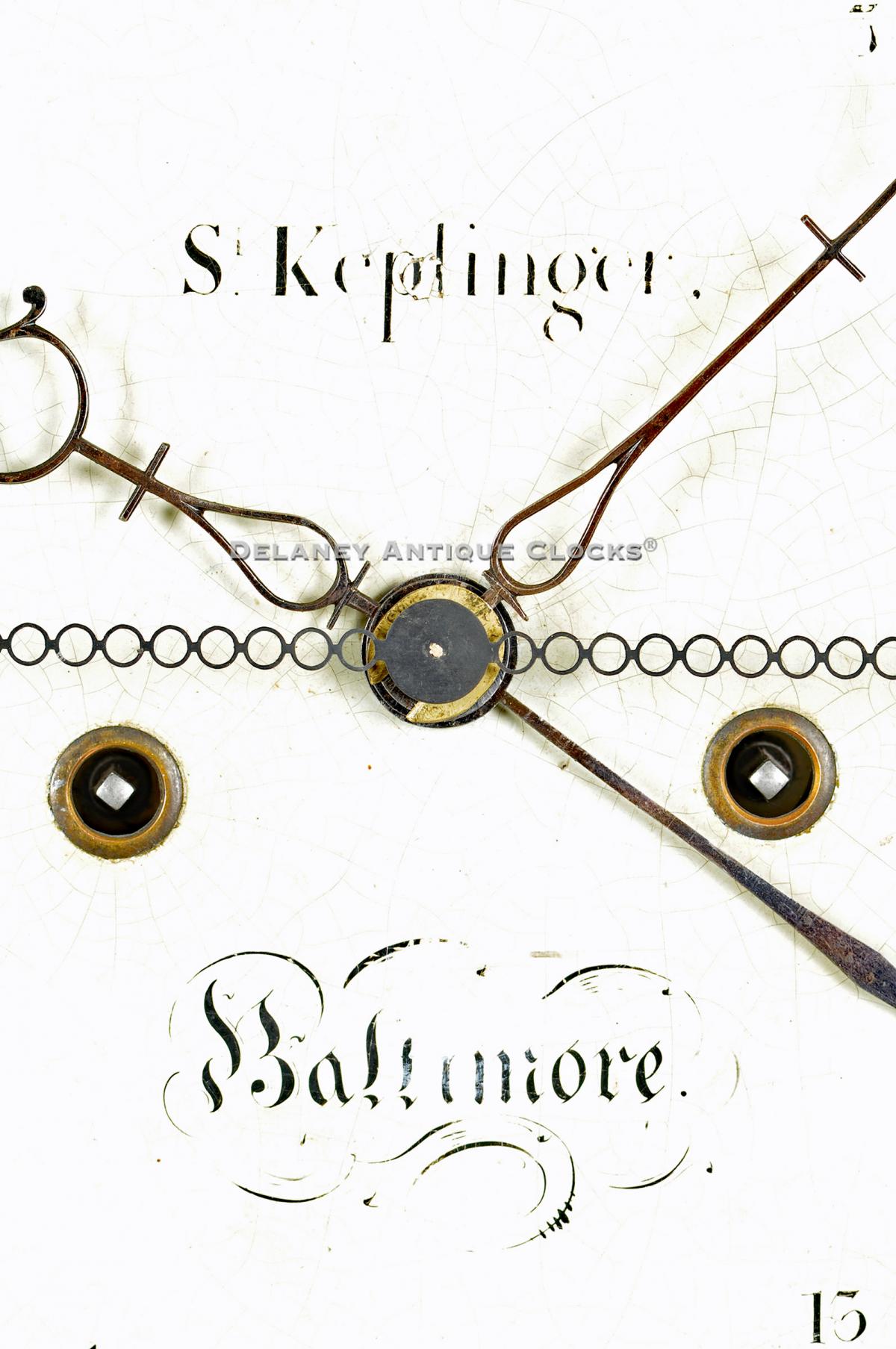An important Hepplewhite tall case clock with a painted dial signed by “S. Keplinger / Baltimore.” Having a mirror in the waist door. 213159.
This cross-banded veneered case features a traditional Boston, Massachusetts form. It exhibits excellent proportions. The base proudly stands cutout bracket feet. The feet and the central drop apron are visually separated from the base by delicate applied molding. A highly figured selection of mahogany is featured in the base panel and framed with a cross-banded mahogany border. The waist is long and features a rectangular waist door. This door provides access to the case's interior, where one will find a brass-covered pendulum bob and two tin can weights. This door is very unusual because it is fitted with a large rectangular mirror. We have seen one other American clock with the very same feature. That case housed a dial and movement made by Aaron Willard of Boston. We have also owned several clocks from London that shared this feature. Those clocks, having Vauxhall mirrors, are also very desirable. This mirror is original to this clock. It is in outstanding condition. We took the back of the door off to confirm this. One should also notice how this door is constructed. The corners are mortised and tenoned to support the glass's weight. The mirror is also framed with a cross-banded border. An applied molding trims the outer edge. The access is by turning the latch. It never had a lock. The sides of the case are fitted with boldly reeded quarter columns. These terminate at both ends in brass quarter capitals. The lower ones are supported by figured veneered plinths. The bonnet features an open fretwork design surmounted with three cast brass ball-and-spiked finials. The supporting plinths are also reeded. Each is fitted with a cap at the top. Fully turned and reeded bonnet columns support the upper bonnet molding. These are mounted in brass capitals and flank the bonnet or hood door. The arched bonnet door is fitted with glass.
This colorfully painted iron dial was manufactured in England by the Walker & Hughes firm. It is fitted with a cast iron false plate and is signed at the top. The dial is oversized, measuring 14 inches across and almost 20 inches in height. In the arch of this dial, one will find the automated feature of a moon phase or lunar calendar. The four spandrel areas are decorated with colorfully painted scenes. Depictions of America, Europe, Asia, and Africa are represented. The time ring is laid out with large Arabic-style hours numerals. You should note that the five-minute markers are absent, indicating that this is a later dial. The subsidiary seconds dial, and a calendar dial are not featured in their traditional format. Instead, a sweep seconds and sweep calendar hands are mounted to the center arbor. This dial is signed by the clockmaker, “S. Keplinger,” in block lettering above the center arbor. His " Baltimore " working location is written in an old English font and is positioned below the center arbor.
The weight-driven movement is constructed in brass and is of good quality. Four-turned pillars support the two brass plates. Hardened steel shafts support the polished steel pinions and brass gearing. The winding drums are grooved. The escapement is a recoil format. The weight-driven movement is designed to run for eight days on a full wind. It is a two-train or a time-and-strike design, having a rack and snail striking system. As a result, it will strike each hour on the hour. This is done on a cast iron bell, which is mounted above the movement.
This wonderful clock was made circa 1820 and stands approximately 8 feet 9 inches ( 105 inches) tall to the top of the center finial. This is a very impressive height.
Inventory number 213159.
Samuel Keplinger is recorded as being born sometime in 1770 and died in 1849. He is listed as working first in Frederick County Co. Maryland about 1800. Then he is found in Gettysburg 1806 -1807. Lastly he is located in Baltimore by 1811 through 1841. Keplinger is listed as a clock and watchmaker . He was also a retailer and a merchant. Numerous advertisements of his business survive due to the preservation of newspapers. They suggest that he did a far amount of business. He advertised a need for a journeyman or two, a servant and a cook. He also advertised having Willard’s patent timepieces in stock. A patent was granted to him for the manufacture of watch chains in 1820. He patented a machine to make the chains.










